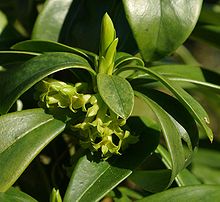Daphne laureola
| Daphne laureola | |
|---|---|

| |
| In flower | |
| Scientific classification | |
| Kingdom: | Plantae |
| Clade: | Tracheophytes |
| Clade: | Angiosperms |
| Clade: | Eudicots |
| Clade: | Rosids |
| Order: | Malvales |
| Family: | Thymelaeaceae |
| Genus: | Daphne |
| Species: | D. laureola
|
| Binomial name | |
| Daphne laureola | |
Daphne laureola, commonly called spurge-laurel,[1] is a shrub in the flowering plant family Thymelaeaceae. Despite the name, this woodland plant is neither a spurge nor a laurel. Its native range covers much of Europe and extends to Algeria, Morocco and the Azores.[1]
Description
[edit]Daphne laureola reaches a height between 0.5–1.5 metres (1+1⁄2–5 ft). The habit of this shrub can be upright or decumbent (arched at the base then spreading upward). The bark is thin and yellow-grey when mature, while immature stems are green. The cambium is malodorous with a scent reminiscent of herb robert.[citation needed]
The alternate leaves usually form dense whorls at the shoot tips, but may clothe entire branches. The leaves are oblanceolate to obovate-oblanceolate, 2–13 centimetres (3⁄4–5 in) long and 1–3 cm wide. They are glabrous (smooth), dark green and glossy on the upper surface and lighter in color beneath.
The inconspicuous yellow-green axial flowers, usually hidden among the leaf bases, may be strongly fragrant, or may exhibit no scent at all.[2] The berry is black, egg-shaped, and 1.5 cm (1⁄2 in) wide, containing one seed.[3]
Etymology
[edit]The genus name Daphne is from the ancient Greek for laurel. Daphne is also the name of a dryad in Greek mythology who was transformed into a laurel tree. The specific epithet laureola means 'laurel-like'; therefore, the binomial literally translates to 'laurel-like laurel'.[4]
Distribution and habitat
[edit]It is one of two species of Daphne native to Great Britain, with Daphne mezereum. Both have a strong preference for alkaline soils and are most commonly found in limestone areas, although D. laureola is also found on clay.[5] However, unlike D. mezereum, D. laureola is evergreen, with yellowish-green flowers borne very early in the spring and black berries, which are poisonous to humans but not to birds, present from late summer.[6]
Ecology
[edit]Birds consume the fruit and disperse the seeds.[3]
As an invasive species
[edit]Outside its native range, D. laureola can become a dangerous invasive weed. Growing in sun or shade, it is well-suited to the temperate forest understory and can rapidly colonize areas (both by seeding and by root suckering) to form monotypic stands and out-compete native vegetation. It is a Class B Noxious weed in Washington state.[7] Already a weed under native forests in Tasmania, Australia,[8][9] and New Zealand.[10]
Hand-pulling is effective against small infestations (gloves must be worn to protect against the caustic sap); shrubs too large or too small to pull must be dug out.[2]
Toxicity
[edit]The fruit is toxic to humans.[3] All parts of the plants are poisonous.[clarification needed] The sap is known to cause skin rashes on contact.
In culture
[edit]Gilbert White called it dwarf laurel, and on 5th December 1783 "fetched them" from the high wood and hanger at Selborne and planted them in his garden.[11]
References
[edit]- ^ a b "Daphne laureola". Germplasm Resources Information Network. Agricultural Research Service, United States Department of Agriculture. Retrieved 4 January 2018.
- ^ a b Washington State Noxious Weed Control Board: Daphne laureola
- ^ a b c Turner, Mark; Kuhlmann, Ellen (2014). Trees & Shrubs of the Pacific Northwest (1st ed.). Portland, OR: Timber Press. p. 296. ISBN 978-1-60469-263-1.
- ^ Gledhill, David (2008). "The Names of Plants". Cambridge University Press. ISBN 9780521866453 (hardback), ISBN 9780521685535 (paperback). pp 134, 232
- ^ Stace, Clive (2010). New Flora of the British Isles (3rd ed.). Cambridge, UK: Cambridge University Press. ISBN 978-0-521-70772-5. pp. 381–382.
- ^ The Reader's Digest Field Guide to the Trees and Shrubs of Britain p.123.
- ^ "Washington State Noxious Weed Control Board". Archived from the original on 2008-08-21. Retrieved 2008-09-09.
- ^ Baker, ML (January 2013). "Daphne laureola L. (Thymelaeaceae): A weedy alien species new to Australia" – via ResearchGate.
- ^ "Daphne Laurel". Hobartcity.au. 2021. Archived from the original on 2021-07-13. Retrieved 13 July 2021.
- ^ "Green Daphne Laurel". Weed Busters New Zealand. 2021. Archived from the original on 2021-02-02. Retrieved 13 July 2021.
- ^ The English Year, compiled by Geoffrey Grigson O.U.P 1967
External links
[edit]- Spurge Laurel, Aliens Among Us. Virtual Exhibit of the Virtual Museum of Canada.
